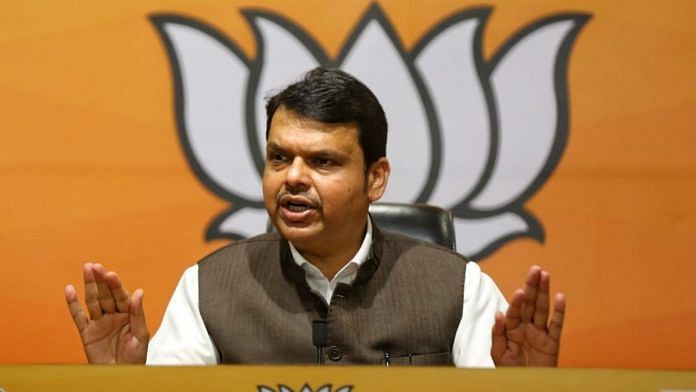Mumbai: Maharashtra has seen a significant number of communal incidents across the state since 2022. It created an ‘us versus them’ divide between Hindus and Muslims, helping the Bharatiya Janata Party whip up a strong Hindutva sentiment in the run-up to the 2024 Lok Sabha and state assembly polls.
A similar violent communal clash this week, though, was puzzling.
The week began with the Vishwa Hindu Parishad (VHP) and Bajrang Dal hitting the streets to demand that Mughal emperor Aurangzeb’s tomb in Khuldabad in the Chhatrapati Sambhajinagar district be razed. The outfits threatened a karseva-like movement if their demand was not met. The protest sparked a violent riot in Nagpur with members of the VHP and Bajrang Dal burning an effigy of the Mughal emperor. There were rumours of a cloth with Muslim holy inscriptions being burnt. The police and Chief Minister Devendra Fadnavis have denied these rumours.
Generally, keeping alive a strong Hindutva sentiment on the ground, and maintaining an ‘us versus them’ narrative to target Congress for alleged Muslim appeasement helps the BJP politically in more ways than one. The BJP has been attempting to grow in Maharashtra by completely taking over the Shiv Sena’s Hindutva mandate and its claim on the legacy of Maratha warrior king Chhatrapati Shivaji.
But, on this occasion, the timing was questionable.
No major elections are coming up immediately, other than local body polls that may or may not be held this year. The BJP has come to power as part of the Mahayuti with its largest-ever tally in Maharashtra, and Fadnavis is using the government’s incontrovertible strength to drive governance. In other words, any major unrest in the state at this point hurts the BJP, or particularly the Fadnavis government, more than it helps it.
This is why Aurangzeb and Nagpur violence is ThePrint’s Newsmaker of The Week.
The Rashtriya Swayamsevak Sangh’s (RSS) headquarters are in Nagpur. Prime Minister Narendra Modi is scheduled to visit the city on 30 March.
Also read: Airtel and Jio are welcoming Starlink to India. Is it a bid to get on Trump’s good side?
The ghost of Aurangzeb
Aurangzeb died as a loser with an unrelenting and unsuccessful Deccan campaign resulting in the significant weakening of the Mughal empire. He has, however, always been a deeply polarising figure that keeps cropping up in Maharashtra’s political discourse.
For decades, Aurangzeb was the focal point of the Aurangabad name-change battle between the undivided Shiv Sena, which was pushing to rename the city Chhatrapati Sambhajinagar, and the Congress, which opposed it.
In 2022, All India Majlis-e-Ittehadul Muslimeen party leader Akbaruddin Owaisi’s visit to Khuldabad stoked a political controversy once again. He laid flowers at Aurangzeb’s tomb.
After Aurangabad’s name change, a few stray incidents in 2023—where some members of the Muslim community allegedly shared social media forwards glorifying Aurangzeb—turned into full-blown communal conflicts. Fadnavis, then deputy CM, called those responsible “Aurangzeb ki auladein” (children of Aurangzeb).
And this time, as CM Fadnavis said, the trigger was the Vicky Kaushal-starrer film Chhaava, which depicts Chhatrapati Sambhaji’s battle with Aurangzeb, and how the latter had tortured the Maratha king to death.
Most of these conflicts haven’t been about Muslims worshipping Aurangzeb per se. They have been more about the perception of Hindus targeting Muslims and politicians fueling the divide.
“The true purpose of historically condemning Aurangzeb is to galvanise anti-Muslim sentiments,” wrote Audrey Truschke, associate professor of South Asian history at Rutgers University, in her book titled Aurangzeb: The Life and Legacy of India’s Most Controversial King.
At Khuldabad, the family of Sheikh Nissar Ahmed—unofficial caretakers of Aurangzeb’s tomb for six generations—talks about why the emperor’s grave is so modest. Aurangzeb, they say, earned his personal expenses by knitting and selling prayer caps.
He wanted his tomb to be built with mud with a basil tree overlooking it, and left open to the sky. In pockets of Chhatrapati Sambhajinagar, some Muslim families also recall his austere ways when asked about him.
But, Hilal Ahmed, a scholar of political Islam and associate professor at the Delhi-based Centre for the Study of Developing Societies (CSDS) wrote for ThePrint in 2022, “Nothing ever made Aurangzeb a Muslim hero. Muslims found it difficult to embrace him as an Islamic icon.”
In the Nagpur violence, the main reason being cited for the tensions is the burning of the cloth, rumoured to have Islamic inscriptions. Elsewhere in the state, the VHP and Bajrang Dal’s protest demanding the tomb’s demolition was relatively uneventful.
The timing
In the run up to the 2024 Lok Sabha and Maharashtra assembly poll, the Opposition Maha Vikas Aghadi alleged that the government is letting investments go to Gujarat. In confidence, industrialists talked about how the investment climate in Gujarat was a notch better—mainly because of political stability and predictability—while Maharashtra’s political landscape had been a rollercoaster since 2019.
Now that the BJP has come back to power in Maharashtra with an overwhelming majority that erases all doubts about the state’s political stability, Fadnavis will likely use this opportunity to show how he strengthened the state’s investments and infrastructure.
His old ‘War room’ is back. The state’s budget has been reined in to limit the incentive-led revenue expenditure surge and focus more on bringing in fiscal discipline. And there is an emphasis on driving mega road projects and small airports in the state’s Tier-2 and Tier-3 cities.
Letting Aurangzeb-related issues fester may keep consolidating the BJP’s Hindutva vote bank in the long term. But unrest like this week’s Nagpur violence also takes away focus from Fadnavis’ governance agenda.
(Edited by Ratan Priya)






